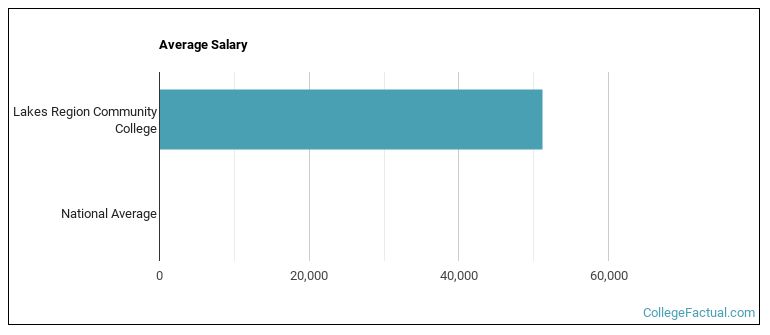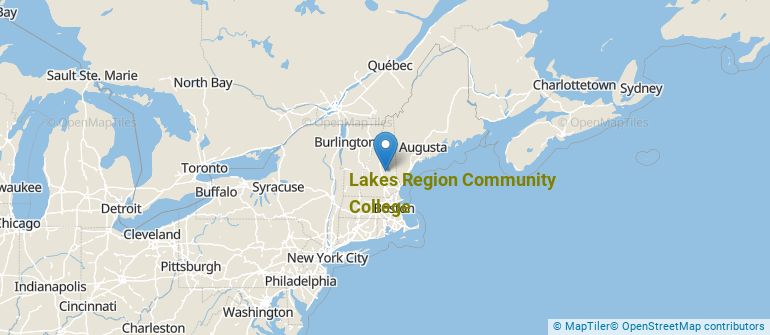 by our College Data Analytics Team
by our College Data Analytics TeamExplore the best ranked schools for the programs you are most interested in.
Lakes Region Community College was not ranked in College Factual's Best Overall Colleges report this year. This may be because not enough data was available.
Returning adults and other non-traditional students may appreciate the fact that Lakes Region Community College has an open admissions policy. This means that you'll only have to submit basic materials, which may include proof that you completed high school or an equivalent program.
The student to faculty ratio is often used to measure the number of teaching resources that a college or university offers its students. The national average for this metric is 15 to 1, but at Lakes Region Community College it is much better at 8 to 1. That's good news for students who want to interact more on a personal level with their teachers.
Another measure that is often used to estimate how much access students will have to their professors is how many faculty members are full-time. The idea here is that part-time faculty tend to spend less time on campus, so they may not be as available to students as full-timers.
The full-time faculty percentage at Lakes Region Community College is 29%. This is lower than the national average of 47%.
The freshmen retention rate tells us what percentage of first-year, full-time students choose to continue on to their sophomore year at a particular school. The rate at Lakes Region Community College is 69%, which is about average when compared to the national rate of 68%.
During the 2017-2018 academic year, there were 697 undergraduates at Lakes Region Community College with 226 being full-time and 471 being part-time.
| $0-30 K | $30K-48K | $48-75 | $75-110K | $110K + |
|---|---|---|---|---|
| $15,528 | $19,917 | $20,021 | $20,021 | $20,021 |
The net price is calculated by adding tuition, room, board and other costs and subtracting financial aid.Note that the net price is typically less than the published for a school. For more information on the sticker price of Lakes Region Community College, see our tuition and fees and room and board pages.
It's not uncommon for college students to take out loans to pay for school. In fact, almost 66% of students nationwide depend at least partially on loans. At Lakes Region Community College, approximately 55% of students took out student loans averaging $5,703 a year. That adds up to $22,812 over four years for those students.
Get more details about paying for Lakes Region Community College.

See which majors at Lakes Region Community College make the most money.
Get more details about the location of Lakes Region Community College.

Contact details for Lakes Region Community College are given below.
| Contact Details | |
|---|---|
| Address: | 379 Belmont Road, Laconia, NH 03246 |
| Phone: | 603-524-3207 |
| Website: | www.lrcc.edu/ |
| Most Popular Majors | Bachelor’s Degrees | Average Salary of Graduates |
|---|---|---|
| Fire Protection | 24 | NA |
| Vehicle Maintenance & Repair | 20 | NA |
| Nursing | 17 | NA |
| Electronics Maintenance & Repair | 14 | NA |
| Liberal Arts General Studies | 12 | NA |
| Business Administration & Management | 8 | NA |
| Teacher Education Grade Specific | 7 | NA |
| Culinary Arts | 7 | NA |
| Accounting | 6 | NA |
| Industrial Production Technology | 5 | NA |
Online learning is becoming popular at even the oldest colleges and universities in the United States. Not only are online classes great for returning adults with busy schedules, they are also frequented by a growing number of traditional students.
In 2022-2023, 320 students took at least one online class at Lakes Region Community College. This is an increase from the 273 students who took online classes the previous year.
| Year | Took at Least One Online Class | Took All Classes Online |
|---|---|---|
| 2022-2023 | 320 | 77 |
| 2021-2022 | 273 | 48 |
| 2020-2021 | 333 | 84 |
| 2018-2019 | 186 | 53 |
Learn more about online learning at Lakes Region Community College.
Footnotes
*The racial-ethnic minorities count is calculated by taking the total number of students and subtracting white students, international students, and students whose race/ethnicity was unknown. This number is then divided by the total number of students at the school to obtain the racial-ethnic minorities percentage.
References
More about our data sources and methodologies.